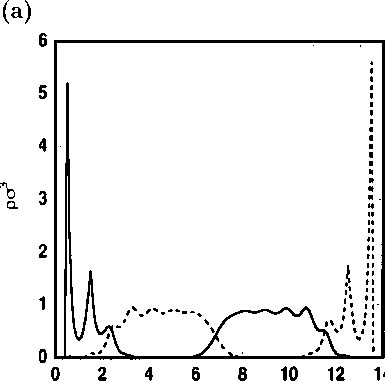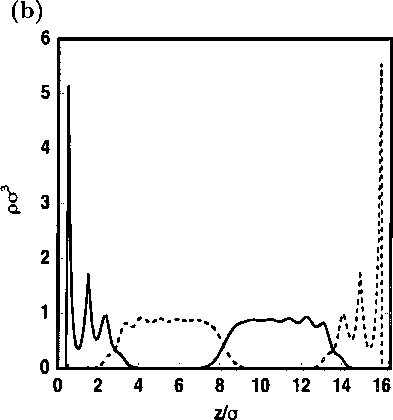
z∕σ

Figure 5.11: Anti-symmetric segment density profiles of the A block (solid black curve)
and B block (dashed black curve) of the copolymer for (a) H = 14σ, and (b) H = 16.4σ.
For the diblock copolymer, N = 8 and e∕kT = 0.289. For surfaces, ew∕kT = 0.3.
number of segments. These diblock copolymers are then confined between two paral-
lel surfaces, where the surfaces selectively prefer one of the blocks of the copolymer,
to form ultra-thin copolymer films. These films show two types of parallel lamel-
lar phases. In symmetric lamellar phases, the preferred block is present at the two
surfaces and in anti-symmetric lamellar phases one of the surfaces is covered with
the energetically unfavorable block. For comparatively weaker surface preference, the
symmetric lamellar phases are stable near integer values of the effective film thick-
ness (Hejγ), when the lamellar period is in accord with ŋð. The anti-symmetric
lamellar phases are stable only at smaller film thickness near half-integer values of
He∕y. However, only symmetric lamellar phases are found to be stable when the sur-
139
More intriguing information
1. Ultrametric Distance in Syntax2. ESTIMATION OF EFFICIENT REGRESSION MODELS FOR APPLIED AGRICULTURAL ECONOMICS RESEARCH
3. The name is absent
4. The name is absent
5. Food Prices and Overweight Patterns in Italy
6. Why unwinding preferences is not the same as liberalisation: the case of sugar
7. The Value of Cultural Heritage Sites in Armenia: Evidence From a Travel Cost Method Study
8. Foreign Direct Investment and the Single Market
9. Federal Tax-Transfer Policy and Intergovernmental Pre-Commitment
10. Estimation of marginal abatement costs for undesirable outputs in India's power generation sector: An output distance function approach.